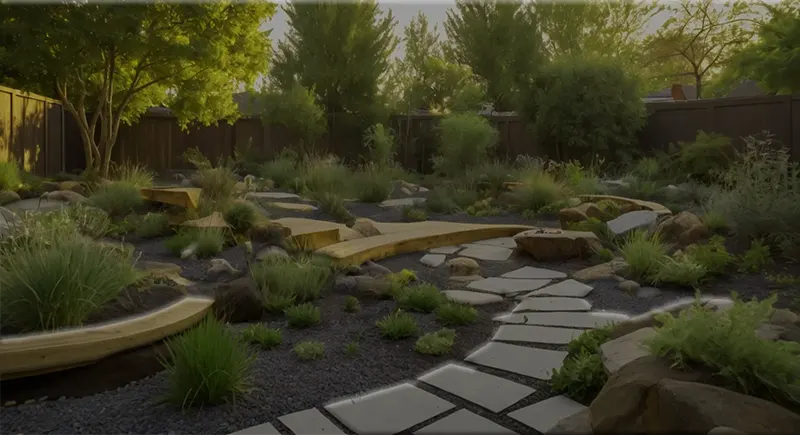Sustainable landscaping goes beyond superficial beauty, channeling efforts toward creating an environment that conserves resources and supports local ecosystems. It is an approach that balances aesthetics with ecological integrity. This comprehensive guide not only delineates the steps needed to amplify the sustainability of your outdoor spaces but also serves as a call to action. It underscores how companies, including those offering commercial landscape services, can be leaders in fostering eco-friendly practices. Embracing sustainable landscaping can engender a connection with the natural world that is both enriching and inspirational.
Key Takeaways:
- Embracing eco-friendly landscaping can lead to significant environmental and resource conservation benefits.
- Implementing strategic water conservation and organic gardening techniques can enhance the vitality of garden ecosystems.
- Integrating renewable energy and maintenance practices is critical in establishing a durable and sustainable landscape.
Table of Contents:
- Understanding Sustainable Landscaping
- Planning Your Eco-Friendly Garden
- Water Conservation Strategies in Landscaping
- Organic Gardening: Benefiting Nature and Your Health
- Hardscaping with The Environment in Mind
- Lawn Care and Alternatives to Traditional Grass
- Using Renewable Energy in Your Garden
- DIY Projects for a Greener Garden
- Maintaining Your Eco-Friendly Landscape
- Advocating for Green Spaces in the Community
Understanding Sustainable Landscaping
At the heart of sustainable landscaping lies the integration of design principles that prioritize eco-consciousness and resource efficiency. The approach encompasses a multitude of practices, all to minimize environmental impact. A genuinely sustainable landscape coexists comfortably with local wildlife, supports natural ecosystems, and requires minimal external inputs for maintenance. The selection of plants, the use of water, and the materials used are all examples of systemic considerations undertaken to minimize carbon emissions and promote global well-being. Before modifying your landscape, it’s crucial to appreciate the existing ecological processes and the state of biodiversity that thrives within your terrain. It’s about becoming a steward of the land, assessing factors like sunlight availability, soil quality, and native plant species that are inherently accustomed to the local environment. Hiring commercial landscape services St Louis MO, can help you make an informed choice based on these observations, laying a solid foundation for sustainable landscaping endeavors.
Planning Your Eco-Friendly Garden
Every sustainable garden begins with an in-depth plan, a blueprint that respects the area’s unique ecology. Critical assessment of soil health and microclimate characteristics dictates plant choices that are both sustainable and harmonious with the existing landscape. Opting for drought-resistant varieties and implementing efficient water management strategies like xeriscaping can reduce a garden’s thirst drastically. These plants show resilience in the face of water scarcity and champion a low-maintenance ethos, trimming the dependence on external resources.
Moreover, bringing native plants into the fold bolsters the local wildlife, providing sustenance and habitat to species that might otherwise struggle in a more cultivated environment. For garden architects and hobbyists alike, resources offer invaluable guidance on nurturing a garden that strikes a chord with the pulse of the ecosystem, combining beauty and functionality with ecological accountability.
Water Conservation Strategies in Landscaping
Water is the lifeblood of any garden, yet its scarcity and the need for sustainable usage are prompting a shift towards conservation-minded landscaping methods. Innovative approaches like rainwater harvesting alleviate reliance on municipal water supply and represent a proactive front against the runoff and erosion issues besetting urban landscapes. These techniques capture and store rainwater for future use, ensuring the garden’s vitality even during dry spells. Comparatively, irrigation strategies such as drip or sub-surface methods serve as targeted water delivery systems, supplying moisture where it is most needed and helping to prevent wastage. Gardeners can wisely use water-saving techniques like these to help create a more environmentally conscious and sustainable community.
Organic Gardening: Benefiting Nature and Your Health
The practice of organic gardening reverberates with nature-focused stewardship. Using natural pest and fertilizer solutions, the garden becomes a haven free from the adverse effects of artificial chemicals. Composting is a cornerstone of organic gardening; recycling kitchen and garden waste into rich humus nourishes plants and promotes beneficial microbial activity within the soil. It’s a natural cycle that fosters a vigorous garden ecosystem. In this vein, an emphasis on biodiversity is critical. Diverse plantings that provide many flowers throughout the seasons ensure a continuous pollinator food source. Their indispensable role in our environment is clear, with their diligent pollination work vital for fruit and vegetable yields, not to mention the garden’s health as a whole.
Hardscaping with The Environment in Mind
Hardscaping, using non-living elements like stone, wood, or metal in garden design, is an opportunity to reflect environmental sensibilities in material choice and installation technique. A primary aim is minimizing impervious surfaces that can exacerbate runoff and hinder natural water absorption. The choice of locally sourced, sustainable materials highlights a respectful approach to the environment, and when coupled with intelligent design considerations, like the incorporation of rain gardens or green roofs, can result in stunning and responsible landscapes. These strategic elements serve a twofold purpose: they contribute to the visual appeal and functionality of the outdoor space while actively reducing the landscape’s ecological footprint. Thoughtfully designed hardscapes can provide habitat diversity, modulate microclimates, and enhance the overall sustainability of the garden.
Lawn Care and Alternatives to Traditional Grass
Lawns are ubiquitous in residential and commercial landscapes and can be resource-intensive. Their need for regular watering, mowing, and fertilization often contrasts with sustainability goals—however, manifold alternatives to traditional grass proffer an appealing aesthetic and ecological advantage. Options like clover, moss, native grasses, and low-growing perennials dramatically reduce the need for water, removing the necessity for frequent chemical treatments. Such choices contribute to water savings and foster a biodiverse habitat for insects and ground-dwelling creatures.
The path to a more sustainable lawn also lies in changing maintenance expectations and practices. It could mean embracing a more natural lawn appearance, adopting organic fertilization practices, and utilizing intelligent watering techniques that prioritize efficiency. Greener spaces sit well within nature’s balance in transforming traditional lawns into alternative landscaping.
Using Renewable Energy in Your Garden
Reducing the garden’s carbon footprint can be accomplished with the help of renewable energy solutions like solar and wind energy technologies. Whether illuminating walkways with solar lights or powering water features with photovoltaic cells, these applications symbolize a commitment to sustainable living. Their role in the garden is not just functional—renewable energy sources can significantly reduce the operating costs associated with garden amenities while also serving as educational examples of clean energy. An eco-conscious mindset permeates choices that extend to outdoor electricals, too. Transitioning to eco-friendly options like electric lawnmowers and tools powered by renewable energy can make routine maintenance more environmentally friendly. The garden becomes a canvas for demonstrating how harmoniously modern living can sync with sustainable practices as renewable technology advances.
DIY Projects for a Greener Garden
The DIY ethos embodies a powerful form of stewardship, enabling anyone to shape their environment actively. Projects that reuse and repurpose materials eliminate waste and foster creativity. A rain barrel, crafted from a repurposed food-grade container, grants a second life to what might otherwise end up in a landfill. When connected to gutter downspouts, it provides the gardener with ample non-potable water. Similarly, constructing compost enclosures from salvaged wood or pallets is a visible pledge toward sustainability, turning decomposable waste into fertile ground for new growth. Crafting habitats for native wildlife, such as birdhouses or insect hotels from reclaimed materials, not only supports biodiversity but also instills a deeper connection to the natural world. These hands-on initiatives promote a greater understanding of and commitment to ecological cycles, solidifying the individual’s role as an integral part of the broader environmental community.
Maintaining Your Eco-Friendly Landscape
Preserving a sustainable landscape is an ongoing journey. Proper maintenance characterizes an ethic of care, where the ecological impact of each action is considered. For instance, mulching with organic materials suppresses weeds, conserves soil moisture, and improves soil health. Natural pest control, perhaps through the introduction of predator species or the application of organic insecticides, ensures that the delicate balance of the garden’s ecosystem remains undisturbed by harsh chemicals. Climate change presents challenges that demand adaptability and foresight in garden planning. Variabilities in weather patterns may necessitate adjustments to planting zones, water conservation measures, and the types of species that can be successfully cultivated. Understanding these dynamics and flexibly responding ensures that the sustainable garden thrives now and in the future.
Advocating for Green Spaces in the Community
Finally, the pursuit of sustainable landscaping is profoundly community-oriented. Green spaces within urban environments offer essential ecological services, from reducing the urban heat island effect to purifying the air and providing a respite for urban dwellers and wildlife alike. Involvement in local green initiatives such as community gardens or city beautification projects underscores the importance of collective effort. These communal endeavors work towards creating healthier, more resilient urban spaces where the synergy between humans and nature can be celebrated and reinforced. The spread of sustainable practices, from private gardens to public parks, marks a transformative shift in our relationship with the landscape. Each contribution to this cause is a step towards healthier, more vibrant communities, where each patch of green serves as both a sanctuary and a symbol of a sustainable future.












